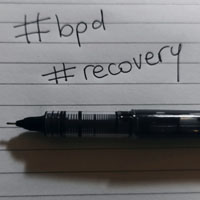Reflective functioning and personal recovery process of users with borderline personality disorder on Instagram: an explorative study using computerized and thematic analysis

Submitted: May 3, 2020
Accepted: September 12, 2020
Published: January 18, 2021
Accepted: September 12, 2020
Abstract Views: 1782
PDF: 666
HTML: 27
HTML: 27
Publisher's note
All claims expressed in this article are solely those of the authors and do not necessarily represent those of their affiliated organizations, or those of the publisher, the editors and the reviewers. Any product that may be evaluated in this article or claim that may be made by its manufacturer is not guaranteed or endorsed by the publisher.
All claims expressed in this article are solely those of the authors and do not necessarily represent those of their affiliated organizations, or those of the publisher, the editors and the reviewers. Any product that may be evaluated in this article or claim that may be made by its manufacturer is not guaranteed or endorsed by the publisher.
Similar Articles
- Kiran Boone, Kennedy M. Balzen, Carla Sharp, Impairment in personality functioning predicts young adult suicidal ideation and suicide attempt above and beyond depressive symptoms , Research in Psychotherapy: Psychopathology, Process and Outcome: Vol. 27 No. 3 (2024)
- Hubert de Condé, Emmanuelle Zech, Jochem Willemsen, The person behind the therapist: a recall study on significant events that contribute to therapists’ personal and professional development , Research in Psychotherapy: Psychopathology, Process and Outcome: Vol. 27 No. 2 (2024)
- Kanika Mehrotra, Poornima Bhola, Geetha Desai, Contextualizing motherhood in persons with borderline personality vulnerabilities: cultural adaptation of the Parent Development Interview-Revised in an Indian context , Research in Psychotherapy: Psychopathology, Process and Outcome: Vol. 26 No. 1 (2023)
- Lidia Borghi, Claudio Cassardo, Elisa Mingarelli, Elena Vegni, The relevance of social dreaming for action research: exploring jail workers’ unconscious thinking of the changes in the prison organization , Research in Psychotherapy: Psychopathology, Process and Outcome: Vol. 24 No. 2 (2021): SPECIAL ISSUE "Working on dreams, from psychotherapy to neuroscience"
- Alexandro Fortunato, Annalisa Tanzilli, Vittorio Lingiardi, Anna Maria Speranza, Psychodiagnostic Chart-Child (PDC-C): a valid and clinically sensitive diagnostic tool for patient-tailored intervention planning , Research in Psychotherapy: Psychopathology, Process and Outcome: Vol. 25 No. 1 (2022)
- Fabiola Bizzi, Francesca Locati, Laura Parolin, Shmueli Goetz Yael, Emanuela Brusadelli, Advancement in the child attachment interview and the child and adolescent reflective functioning scale using a PDM-2 framework: case reports , Research in Psychotherapy: Psychopathology, Process and Outcome: Vol. 25 No. 1 (2022)
- Laura Parolin, Alberto Milesi, Giovanni Comelli, Francesca Locati, The interplay of mentalization and epistemic trust: a protective mechanism against emotional dysregulation in adolescent internalizing symptoms , Research in Psychotherapy: Psychopathology, Process and Outcome: Vol. 26 No. 3 (2023)
- Saryn R. Levy, Mark J. Hilsenroth, Francine Conway, Jesse Owen, Patient personality characteristics and therapeutic integration: treating borderline personality and emotionally dysregulated-dysphoric personality features , Research in Psychotherapy: Psychopathology, Process and Outcome: Vol. 25 No. 2 (2022)
- Guillermo de la Parra, Paula Dagnino, Camila Valdés, Mariane Krause, Beyond self-criticism and dependency: structural functioning of depressive patients and its treatment , Research in Psychotherapy: Psychopathology, Process and Outcome: Vol. 20 No. 1 (2017)
- Margarida Pedroso de Lima, Isabel Albuquerque, Paulo Jorge Martins, António-José Gonzalez, Personal Projects Analysis as an idiographic approach in psychotherapy: an exploratory study , Research in Psychotherapy: Psychopathology, Process and Outcome: Vol. 26 No. 1 (2023)
You may also start an advanced similarity search for this article.

 https://doi.org/10.4081/ripppo.2020.463
https://doi.org/10.4081/ripppo.2020.463





